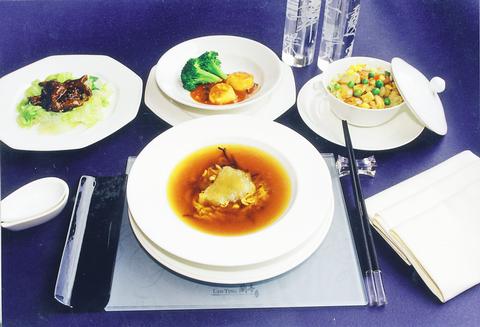Lan Ting (
The name of the restaurant and many of the design motifs are taken from the Lan Ting Prologue, conventionally regarded as one of the most influential works of Chinese calligraphy. Calligraphy created from backlit plexiglas lines the corridor to the main dining area, which is nicely lit in the afternoon by large windows, and affords a view of Taipei's bustling Chungshan North Road by night. A large number of private dining areas are also offered, some with views onto the street, while others aim at the intimacy of total seclusion. These rooms, which combine installation art with calligraphy, coupled chairs upholstered in cream-colored leather and highly polished black wood tables, have the serenity of a museum.

PHOTO: COURTESY OF GRAND FORMOSA HOTEL
The set menus provide individual servings that allow even individual diners the opportunity of working their way through four or five dishes. Both lunch and dinner set menus feature items such as shark's fin, snow frog cream (雪蛤露), whole Chinese scallops, abalone and even ostrich.
Presentation is elegant but relatively simple, and while some specialties like the braised shark's fin with chicken consomme speak for themselves both in terms of appearance, texture and taste, not all the dishes are able to stand out sufficiently. The fresh scallops with spicy sauce, while tasting fine, made one just a tad suspicious about what all the fuss is about. Catherine March, PR specialist for the hotel, said that the restaurant was still in the process of fine-tuning the menu.
A definite must from the a la carte menu is the milk pudding with mango, a light-as-a-feather concoction of the hotel's executive chef Huang Lai-fa (黃來發).
Service is formal yet friendly, but fails to quite live up to the atmosphere of sophistication established by the design, a frequent failing in hotel restaurants. For all that, dining at Lan Ting is a "dining experience" that is almost worth its price.

May 26 to June 1 When the Qing Dynasty first took control over many parts of Taiwan in 1684, it roughly continued the Kingdom of Tungning’s administrative borders (see below), setting up one prefecture and three counties. The actual area of control covered today’s Chiayi, Tainan and Kaohsiung. The administrative center was in Taiwan Prefecture, in today’s Tainan. But as Han settlement expanded and due to rebellions and other international incidents, the administrative units became more complex. By the time Taiwan became a province of the Qing in 1887, there were three prefectures, eleven counties, three subprefectures and one directly-administered prefecture, with

It’s an enormous dome of colorful glass, something between the Sistine Chapel and a Marc Chagall fresco. And yet, it’s just a subway station. Formosa Boulevard is the heart of Kaohsiung’s mass transit system. In metro terms, it’s modest: the only transfer station in a network with just two lines. But it’s a landmark nonetheless: a civic space that serves as much more than a point of transit. On a hot Sunday, the corridors and vast halls are filled with a market selling everything from second-hand clothes to toys and house decorations. It’s just one of the many events the station hosts,

Among Thailand’s Chinese Nationalist Party (KMT) villages, a certain rivalry exists between Arunothai, the largest of these villages, and Mae Salong, which is currently the most prosperous. Historically, the rivalry stems from a split in KMT military factions in the early 1960s, which divided command and opium territories after Chiang Kai-shek (蔣介石) cut off open support in 1961 due to international pressure (see part two, “The KMT opium lords of the Golden Triangle,” on May 20). But today this rivalry manifests as a different kind of split, with Arunothai leading a pro-China faction and Mae Salong staunchly aligned to Taiwan.

Two moves show Taichung Mayor Lu Shiow-yen (盧秀燕) is gunning for Chinese Nationalist Party (KMT) party chair and the 2028 presidential election. Technically, these are not yet “officially” official, but by the rules of Taiwan politics, she is now on the dance floor. Earlier this month Lu confirmed in an interview in Japan’s Nikkei that she was considering running for KMT chair. This is not new news, but according to reports from her camp she previously was still considering the case for and against running. By choosing a respected, international news outlet, she declared it to the world. While the outside world